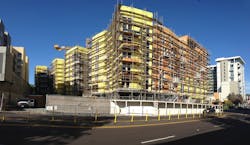Buildings On Fire: Buildings Characteristics: What Happens During a Fire?
Fire chiefs, officers and firefighters responding to structure fires must have an understanding of buildings and the fire company members’ skills and experience, as these form the fundamental core relationships of performance on today’s demanding fireground and will continue to directly influence operations into the foreseeable future.
The building
• Comprehend and apply principles of a building’s anatomy related to construction systems, occupancies and risk, compromise and collapse, materials and methods and fire dynamics.
• Understand the building, its design, layout, functional use and occupancy risks. Be able to identify, comprehend and assess inherent characteristics that affect predictable performance of the building in static (non-fire) and fire-impacted conditions, then understand and apply them.
• Comprehend and apply crucial engineering and structural principles that affect building integrity, compromise and collapse based on fire assault, impingement or exposure.
• Recognize and assess internal and external collapse zone management considerations.
• Understand the impact of engineered structural systems, components and assemblies.
• Recognize and apply the principles of building resiliency, integrity and time (“B-RIT”) to fireground operations that may influence operational excellence.
The compartment
• Understand the compartment unit(s) role within the building envelope.
• Understand the relationships of connectively of compartment within the building structure and influence of vent path and flow path principles.
• Comprehend and apply information about the fire load package and heat release rate (HHR) and their influence on fire suppression requirements, delivery rates, limitation, required fire flow rates and the impact on the building’s anatomy, integrity and resiliency.
• Understand the fundamental compartment relationships that comprised a typical room configuration in terms of area (square footage), volume (height/width), furnishings (fire load package) and materials of construction (structural anatomy) within conventional, legacy or heritage construction provided predictability in terms of fire suppression, fire behavior, operational time and survivability (civilian/firefighter).
• Attain proficiencies in the principles of fire dynamics and fire behavior and their relationship to the compartment, structure and operations.
The company
• Attain and sustain of skill set levels, knowledge and proficiencies commensurate with roles, responsibilities, assignments and functions related to buildings, structures and occupancies in the assigned response area.
• Be able to identify, recognize, comprehend and apply key performance attributes of buildings that may directly or indirectly influence company level assignments or fireground actions.
• Skill sets to efficiently and accurately read and assess a building, identify and apply performance based indicators and determine and apply occupancy risk to operational incident actions, plans and tasks.
• Maintain the highest standards in proficiencies, knowledge, skills and abilities related to functional company assignments and their influence by buildings in the jurisdiction in order to achieve consistent operational excellence.
The identification, assessment, probability, predictability and intrinsic characteristics of the building and its expected performance under fire conditions must be identified, assessed and integrated into an adaptive fire management model and flexible incident action plan that formatively based upon the building.
The gaps that still prevails in many fire departments across the county and is a direct apparent, common or root cause performance based contributor, continues to be the explicit lack of building knowledge related to design, construction, engineering and systems and how a building (type) can be affected by fire in today’s context. The fire service in general does not have a sufficient advancement of knowledge beyond basic fundamentals within the building and engineering sciences that equate to fireground proficiency that are demanded by today’s structure fires. It is important to understand how building-occupancy relationships; construction sciences; occupancy risk profiling, fire dynamics and fire behavior; dynamic risk analysis, with progressive art and science of firefighting practices are to be implemented with effective incident commanders, company-level supervision and task-level competencies.
First-arriving units
The ability for the first-arriving company, company officer or commander to perform an accurate identification of building type, classification and vintage are formative toward anticipating variables in structural integrity and resiliency to the effects of rapid fire development or extreme fire behavior, accelerated fire load package growth rates and intensity levels typically encountered in today’s composition and arrangement of buildings and their associated construction systems during initial and sustained fire suppression. Arriving companies and personnel at a structure fire must be able to rapidly and accurately identify key elements of a building, process that data based upon a widening field of variables present on today’s evolving fireground and implement timely actions that address prioritized actions requiring intervention.
Deterministic fireground models for size-up and suppression have to give way to a more expandable stochastic, or random, model of building assessment, profiling and performance basis that are beginning to be aligned subtly to defined tactical practices. Key to this is having a broad and well-developed foundation of building knowledge, with advanced studies and insights as rank, roles and responsibilities increase for fireground operations.
Benefits of research
Today’s emerging fireground and structural fire engagement require a balance of tactical discipline, tactical patience and predictive insights of the building executed within an Adaptive Fireground Management (AFM) model. The evolution of the AFM model will be a key functional element that suggests a methodology and practices that integrate the insights provided by current and future fire research, improvements in suggested firefighting principles and practices derived from research or practical improvements.
The broad and encompassing discipline of building construction sciences is a formidable and, at times, a daunting subject area to fully understand or to extend beyond the basic fundamentals that are applied in recruit school, gleaned from short seminars or layered upon from years of in-house drills, training sessions or from anecdotal assimilation or on-line self-learning. Training and education on the subject of building construction have been established in varied forms within the United States and United Kingdom fire services for well over 120 years. The original International Fire Service Training Association (IFSTA) Red Book publications of the 1940s and 1950s and the subsequent publication and dissemination of fire service textbooks in the late 1950s to the early 1970s expanded and broadened the fire service’s perspectives and established the foundation of knowledge of building construction as it related to fireground operations and firefighting. It was also a time when the rules of structural firefighting and engagement and building and occupancies had a level of consistency, predictability and resonance.
There have been varying degrees of change or revision during the past 15 years, but no major overhaul of building construction-fire service curricula, pedagogy or learning that truly align with the significant advancements in architecture, design and engineering, building sciences, material technologies and systems or their alignment with fire protection engineering advancements and fire and building sciences research findings.
• We have certain expectations that fire will travel in a defined (predictable) manner; that fire will hold within a room and compartment for a predictable given duration of time; that the fire load and related fire flows required would be appropriate for an expected size and given an appropriately trained and skilled staff to perform the requisite evolutions; we could safely and effectively mitigate a structural fire situation in any given building type and occupancy- with negligible consequences most often.
• The risks were more often known, manageable and part of the job of firefighting.
• We assumed and most often did have the adequacy of time to conduct and employ the required tasks identified to be of importance based upon identified or presumed indicators; and that the building would conform to the rules of engagement.
• Time-proven fire suppression methodologies and tactical practices employed would be appropriate for the given building, fire and circumstances presented at the incident.
We have assumed that the “routine-ness” or successes of past operations and incident responses equates with predictability and diminished risk to firefighting personnel, but our current generation of buildings, construction and occupancies are not as predictable as past construction systems, occupancies and building types. This requires increased knowledge of building anatomy, systems and risk-assessment models with consequential strategies and tactics being highly adaptive to address these evolving rules of combat structural fire engagement in today’s buildings that challenge anecdotal practices and methodologies and the need to be based on effective building profiling and assessments.
The challenge is to identify your personal, company- or department-level capabilities, knowledge and skills sets and recognize any gaps and limitations, and then build an effective education, training or competency skill set action plan to address those varied attributes in a desired time frame. Recognize and distinguish early on that there are many variables and options in the manner in which you can attain or achieve these areas of improvement.
CHRISTOPHER J. NAUM, SFPE, a Firehouse® contributing editor, is a 39-year fire service veteran and national instructor, author and lecturer. He is an authority on building construction issues affecting the fire and emergency services and a former fire command officer, architect and fire protection engineer. Naum is a technical consultant to the NIOSH Firefighter Fatality Investigation and Prevention Program, a NFFF Firefighter Safety Advocate and served on the Board of Directors of the ISFSI and the IAFC Safety, Health & Survival section and faculty at the National Fire Academy. He is the executive producer of Buildingsonfire.com, a site dedicated to building construction, adaptive fire command and firefighter safety.
Connect with Chris
Email: [email protected] & Buildingsonfire.com
Facebook: Buildingsonfire
About the Author
Christopher J. Naum
CHRISTOPHER J. NAUM, SFPE a Firehouse® contributing editor, is a 40-year fire service veteran and a national instructor, author, lecturer and fire officer. He is an authority on building construction issues affecting the fire and emergency services and a former fire command officer, architect and fire protection engineer. Naum is a technical consultant and reviewer to the NIOSH firefighter fatality investigation and prevention program, an NFFF Firefighter Safety Advocate and formally served on the Board of Directors of the ISFSI and the IAFC Safety, Health & Survival section and faculty at the National Fire Academy. He was the 1987 ISFSI George D. Post National Fire Instructor Award recipient. Naum is the executive producer of Buildingsonfire.com and FiregroundLeadership.com, sites dedicated to building construction, adaptive fire command and firefighter safety.

